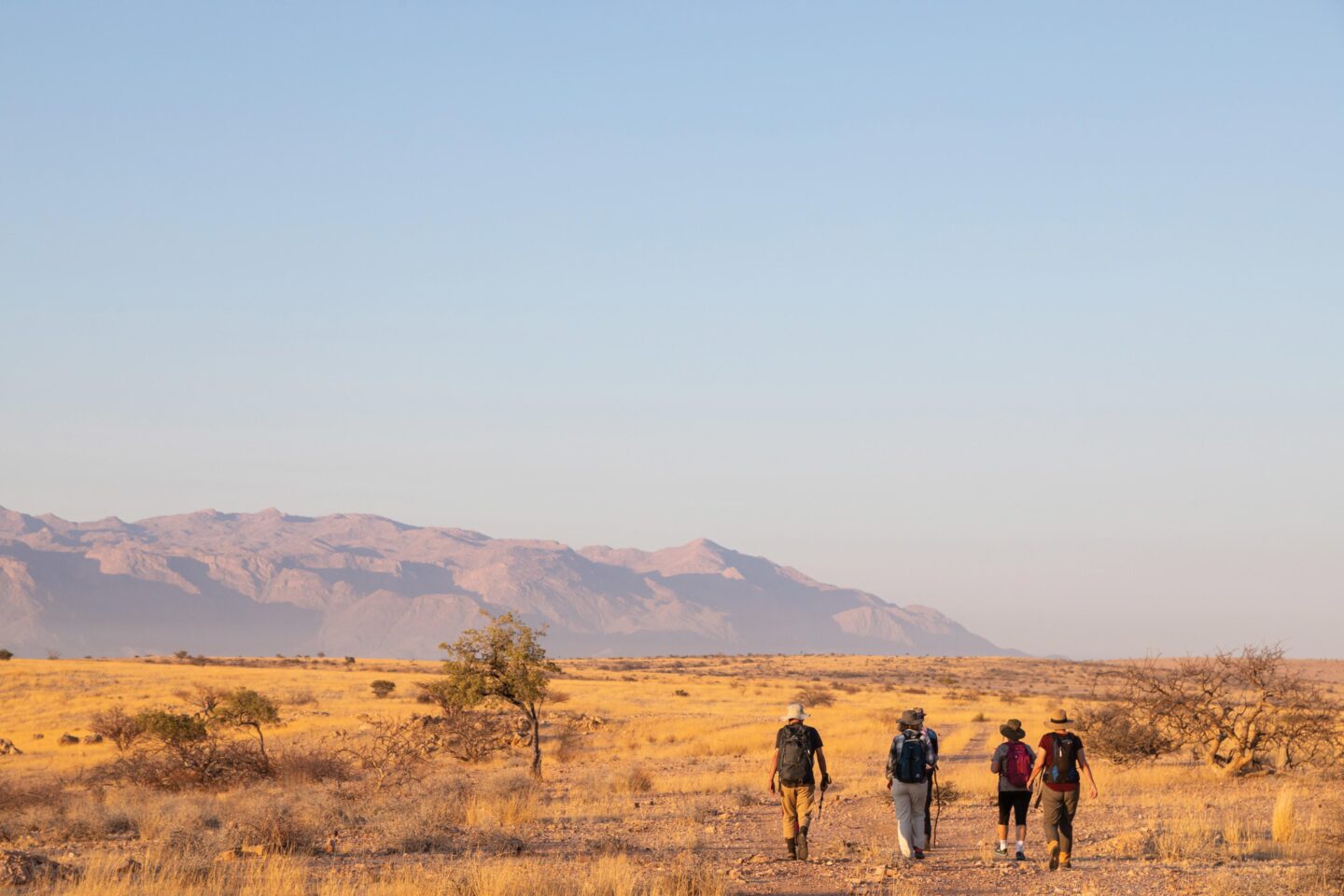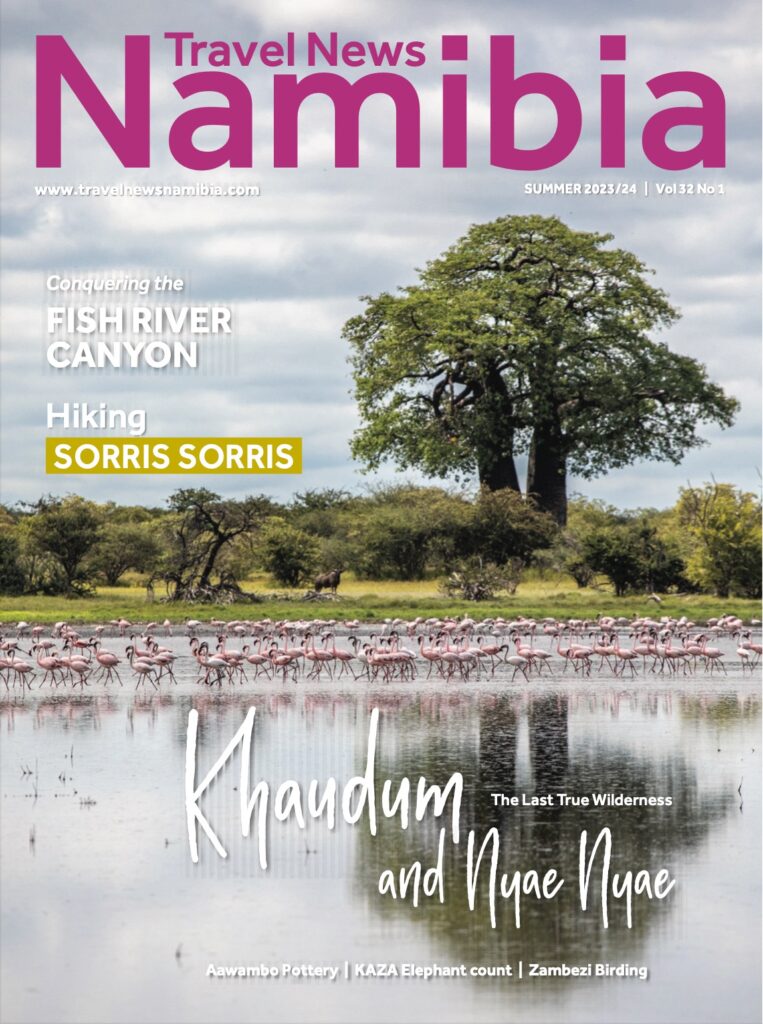

A Hike In The Shadow Of Brandberg
I hear the familiar crunch of my hiking boots on the sand as the sun peeks from the granite koppies behind Madisa Camp. It is the start of a four- day slackpack hike. The first two days will take us down into the Ugab River, and on the other two we will follow the bends of the river course as we make our way upstream. It is the land of desert-adapted elephants, magical landscapes and Brandberg Mountain. Exploring this area on foot is a new experience for me – and I am savouring it.
Text Le Roux van Schalkwyk | Photographs Le Roux van Schalkwyk
From the Summer 2023/24 issue
Iam fortunate enough to be part of the first group on this new hike called the Damaraland Hiking Safari which will officially start in 2024. It is the brainchild of Kelly Beukes and Claire Whipp. Claire, the owner of Madisa, and Kelly, who has a life- long love for hiking and making food, teamed up to offer an unforgettable experience in the heart of Damaraland.
The first night is spent at Madisa Camp and I get to know my hosts and fellow-hikers Larry Dolley, Alta Bredenkamp and Helga Frielingsdorf. After a hearty meal we retire to our tents and get a good night’s rest.
DAY1
Our guides for the walk are Jessica Meriam Kharuxas and Karneels Thaniseb.
Karneels is originally from a tiny village at the foot of Brandberg. His training from Elephant-Human Relations Aid will ensure that if we run (or rather walk) into elephants we will be able to get around them safely. Jessica, who is also a local from the area, works as a rhino ranger and her extensive knowledge and experience of the region is invaluable.
We start the hike by passing the granite koppies behind Madisa Camp, heading in a southwesterly direction. Our first stop is a rock finger formation not far from where we set out. Compared to the Vingerklip, the small rock protruding in the shape of a finger might not be as impressive but it is nevertheless a sight.
The route takes us through mopane bushes sprouting new leaves. Karneels and Veronica share intriguing traditional knowledge about the plants we pass and some are worth remembering when in need – like eating the smelly leaves of a shepherd tree to stop a runny tummy.
The dry landscape is surprisingly full of life. A couple of Northern Black Korhaans keep us company flying overhead and giving their piercing kraak-kraak-kraak calls. Entering a clump of trumpet thorns we see a Kori Bustard, and a lone springbok taking flight. Our guides point to steenbok pellets and easily identify every animal spoor we come across.
At a dry pan Karneels tells us that this place is favoured by elephants when it holds water. That is evident by their rub marks high on the surrounding mopane trees where clay from their backs sticks like plaster to a wall.
Our brunch is on a dune under a gazebo. Apart from other tasty treats, Kelly rustles up some flapjacks on a gas stove. A perfect companion meal for the view we have of Brandberg dabbled in purple hues and etched against a blue sky. On the dune we find perfect devil’s claw specimens with their mangled hooked arms protruding from the fruit.
When we continue, the sand is more compressed and it is relatively easygoing. We explore the remains of a Decca station – a relic from the past used for navigation by ships and aeroplanes before GPS became available for public use.
We arrive at our camp at lunchtime. Tents, showers and a toilet were all set up by Claire’s husband Brett Leask and their team. As a welcome surprise, foot baths are waiting for every hiker to soothe tired feet.
Our camp is situated on a slight rise that dominates an otherwise flat terrain with a 360-degree view of the area. As the day winds down and during the golden hour in which the sun starts setting we watch the horizon turn from shades of purple to blue and finally darken into an orange haze.
DAY 2
After a restful night, we wake revitalised and ready to take on the next day. A quick breakfast of coffee and rusks, and we set off on the next leg of the hike. The day’s trek takes us down a continuous decline, the result of thousands of years of water erosion, until we finally reach the Ugab River. Brandberg is
the only constant while the landscape and plant life gradually changes during our descent to the river.
Following a twisty jeep track we pass some granite inselbergs along the way. We have a chance to observe the broom-like crowns and reddish-brown stems of endemic Brandberg acacias from up close. A nice tree for hobby-botanists to tick off their lists.
At some point, Jessica and Karneels suddenly stop and without saying a word start kicking sand away at a spot where the solid ground has been disturbed. With their boots, they dig out the scat of an aardwolf. “You burn the scat in your house to get rid of any nightwalkers (bad spirits). You can also make a tea of it to cleanse your innards,” Karneels explains. Quite a handy item to have in your bag, I think to myself.
After a slog of 18 kilometres we reach the river at Elephant Rock. Erosion has formed the granite into the perfect profile of an elephant. Fitting for the Ugab, well known for its desert- adapted elephants.
Shortly after we reach our campsite, cocooned underneath the arms of two massive Ana trees. The highlight of the day comes after lunch when Bennie, an elephant bull, decides to feed on Ana trees on the river bank across from us. Relaxing in our shaded campsite we had the best view of this massive grey beast slowly stripping the branches of leaves above its head.
DAY 3
We set off upstream early in the morning, just as the sun rises behind a koppie and peeks through some light clouds. The next two days the hike takes us upriver and that means walking on sand. The going is slightly tougher than the previous days but it is made easier with the shade from giant Ana trees and occasional leadwoods on the riverbanks. Furthermore, we try to keep to the side of the river where the sand is a bit more compressed.
Since the elephants constantly walk up and down the river because this is where food and water is readily available to them, we are constantly on the lookout. To ensure that we don’t bump into them where it might be dangerous for us, our guides circumnavigate a section with a natural spring and where the river is quite narrow.
Unfortunately, we don’t see any of the big-eared beasts but we bump into seemingly the second-most dangerous animal of the Ugab – two Brahman bulls about to brawl. The literal clash of heads happens in the middle of the river. Not risking getting in their way we stand amongst a clump of tamarisk bushes, allowing the fight to end and the moody winner to make his way downriver before we head on.
Another shady campsite awaits when we arrive at lunchtime. It has become the norm over the previous couple of days
to spend the afternoon relaxing in cool shade and taking a well-deserved nap before we have another of Kelly’s scrumptious dinners.
DAY 4
The last day is another march upriver and the sand works the weary legs, but we are so distracted by the sights and sounds of the river that we are not bothered. In some narrow sections, the canopies of the Ana trees from each side of the river touch, making for fairytale scenes in the early morning light.
We also stop to look at huge trees uprooted and deposited along the river banks during the last flood the previous year. Stunning garden ornaments, if only there were a way to get them to your garden – but then you also need a yard of some size to fit these behemoths.
The day consists of a short trek of 9 kilometres before we stop for our last brunch under the bulging canopy of a leadwood tree. Driving in the guide vehicle back to Madisa, it feels strange to navigate the last segment of the river at a speed not known during the hike. I realise how much more intimate the experience of this remarkable river was going at a slow pace and how I already miss it. TNN
HOW IT STARTED
After going through a difficult period in her life Kelly did the 150 km Camino on the Kunene River and realised she could channel her passion for hiking and her background in hospitality into a new career path. A mutual friend of Kelly and Claire introduced them, and the concept of a slackpack trail in Damaraland was born.
“The act of walking allows for introspection and also the sharing of life experiences in a non-threatening fashion. In addition, my love of wildlife, and elephants in particular, made for a wonderful match in creating something unique for visitors to Namibia. Desert-adapted elephants live against the backdrop of Brandberg in Damaraland. Now I can share these loves in a mutual relationship.”
ABOUT THE DAMARALAND HIKING SAFARI
We covered 68 km in four days. The average per day was around 20 km, but only 9 km on the last day. It is a fairly easy hike, and since you only carry a backpack with water and snacks it is doable for most ages and fitness levels.
- The first and last night spent at Madisa Camp is included in the price.
- Hikers need to bring their bedding, the rest is provided. It is a fully catered hike; you can bring snacks to keep up the energy levels during the hike.
- It is important to note that this was the first hike and some small details might change when it officially starts next year, but needless to say that will not affect the experience.
Price per person (excluding conservancy fees):
N$ 20,000
For more information visit whippswilderness.com or email: ✉️
More to explore


Lüderitz Nest Hotel: A New Era of Elegance on Namibia’s Shores





